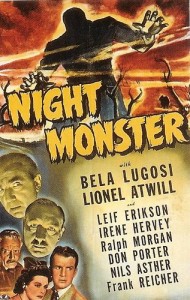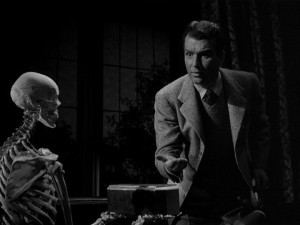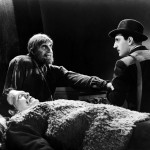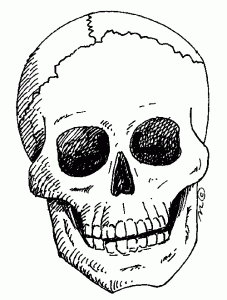“Karswell, you’ve sold your bill of goods too well, because I believe you now. I believe that in five minutes something monstrous and horrible is going to happen. And when it does, you’re going to be here, so that whatever happens to me will happen to you.” —Dr. John Holden, Night of the Demon
Not hard to find five horrible old movies, especially in these artistically bereft times when “horrible” films come aplenty, whether or not intentionally meant to be in the horror genre. Following the appearance on this site of “Five Westerns,” popular demand has prompted a similar discourse on old horror flicks of note, or, in the case of two, not of much note. These five films, in this case intended as legitimate horror creations, are listed in order of personal preference.
 Let’s begin with the weakest of the five. No, one should justify any such judgment as “a matter of taste.” But, no, this is the weakest of the five! Directed by Ford Beebe, Night Monster comes from 1942 when the luster of Universal as the master of the macabre was clearly in decline. Bela Lugosi, well into his own physical and mental collapse, was relegated to the role of butler Rolf, wandering from room to room and announcing dinner most indolently; he was, in fact, one of the least menacing, disturbed or eccentric of the characters.
Let’s begin with the weakest of the five. No, one should justify any such judgment as “a matter of taste.” But, no, this is the weakest of the five! Directed by Ford Beebe, Night Monster comes from 1942 when the luster of Universal as the master of the macabre was clearly in decline. Bela Lugosi, well into his own physical and mental collapse, was relegated to the role of butler Rolf, wandering from room to room and announcing dinner most indolently; he was, in fact, one of the least menacing, disturbed or eccentric of the characters.
As in all of these five submitted movies, an old, creepy house is involved to one degree or another; here, along with one of the other four, a house is central to the plot. In Night Monster, there is an abundance of fog around the Ingston Mansion and on the road leading to it. Fog was probably essential to hide a barren set. Croaking frogs are so prevalent that cast credits are almost expected, or, if the film were made in these days, a statement that “No amphibians were injured in the making of this film.” But beware—when the frogs stop croaking, something’s up!
Three medical doctors are summoned to the old house by their patient, the legless, wheelchair-bound Kurt Ingston (Ralph Morgan, brother of Frank, Professor Marvel in The Wizard of Oz). Lionel Atwill is one of the doctors, though here unusually low-key. Two others arrive at the mansion—psychiatrist Dr. Lynne Harper (Irene Hervey), come to assess the sanity of Ingston’s disturbed daughter (Fay Helm), and Dick Baldwin (Don Porter), in answer to threats against Doctor Harper. A practically live-in guest is Agor Singh (Nils Asther), a Hindu yogi, expert in the mystic ways of Eastern mind therapy. Thrown into this brew is another possible suspect, Laurie (Leif Erickson), the cocky chauffeur who hits on all the women.
“Suspect,” did I say? Yes. One by one, the three medical doctors are being murdered and there are inexplicable blood blotches on the floor. Who? How? For those who haven’t seen the movie, whenever there’s a character in a wheelchair, what are the chances he’s the murderer?— Usually pretty high. But, wait a minute, in this case Ingston has no legs. Maybe an alibi, maybe not. Just something to consider.
 A highly prolific composer for many Universal pictures of the period, Hans J. Salter makes the music one of the strongest ingredients in the film, providing a creepy atmosphere behind the main title, which, as in most of Universal’s monster movies, traverses that familiar desolate, fog-enshrouded landscape. Maybe the music is too good, for the film never quite delivers on the ominous anticipation aroused by the main title, though the murderer’s modus operandi is different.
A highly prolific composer for many Universal pictures of the period, Hans J. Salter makes the music one of the strongest ingredients in the film, providing a creepy atmosphere behind the main title, which, as in most of Universal’s monster movies, traverses that familiar desolate, fog-enshrouded landscape. Maybe the music is too good, for the film never quite delivers on the ominous anticipation aroused by the main title, though the murderer’s modus operandi is different.
Behind the camera is Charles van Enger, a rather undistinguished cinematographer. So why mention him? Well, his greatest claim to fame is his uncredited work on the 1925 Lon Chaney, Sr. Phantom of the Opera. He spent the last ten years of his career in television—Lassie, The Betty Hutton Show, Gilligan’s Island, etc.
Point of interest: The minor role of the gatekeeper, Torque, is played by Cyril Delevanti, whose best film role is Nonno, the aged poet in The Night of the Iguana.
 Lionel Atwill and Bela Lugosi from Night Monster also appear in the next horrible old movie, again from Universal, though a considerable step up. The Son of Frankenstein was made in that same glorious year, 1939, as The Bride of Frankenstein. Rating top billing, in order, are the three “Bs”—Basil Rathbone, Boris Karloff and Bela himself.
Lionel Atwill and Bela Lugosi from Night Monster also appear in the next horrible old movie, again from Universal, though a considerable step up. The Son of Frankenstein was made in that same glorious year, 1939, as The Bride of Frankenstein. Rating top billing, in order, are the three “Bs”—Basil Rathbone, Boris Karloff and Bela himself.
The director this time is Rowland V. Lee, also a step up from the mediocre Beebe. Lee did direct, all in the ’30s, The Count of Monte Cristo, The Three Musketeers and Tower of London, and, in 1944, The Bridge of San Luis Rey, among other films. The music is by Frank Skinner, like Salter a stalwart composer for Universal.
Basil Rathbone has taken time off as Sherlock Holmes—20th Century-Fox had released in 1939 both The Hound of the Baskervilles and The Adventures of Sherlock Holmes—to play Baron Wolf von Frankenstein. Yes, Henry Frankenstein’s son has returned with his wife (Josephine Hutchinson) to the scene of his father’s crime, as it were, to claim his inheritance.
Off to what might seem a shaky start, in the opening train ride is that famous tree, which passes outside the window several times! The look of the film, however, is one of the best in the Frankenstein series. The art direction is by Jack Otterson, set direction by the ultra prolific Russell A. Gausman, who seems to have done everything—the Universal Sherlock Holmes films, a few Alfred Hitchcocks and, scattered throughout his long career, Dracula, The Wolf Man, Scarlet Street, The Killers, as well as—small world!—the aforementioned Night Monster. Often in collaboration with Otterson at Universal, Gausman spent his later years in television, but ended his film career with a bang—a shared Oscar for Spartacus in 1960.
The sets are done in that German expressionistic style typical of many Universal films of the period. In the Frankenstein mansion, the suspended, modernistic staircase with its over-bright lighting is perhaps the pièce de résistance, but effective in its own right is the great hall, with the high ceiling and the large window beyond which lightning flashes, often in the same pattern.
 Lugosi, in probably his best role as Ygor of the crooked neck, is the “friend” of the Monster. Ygor tricks Wolf Frankenstein into reviving the Monster. Wolf should know better, but he apparently left his Sherlock Holmes brain at 221B Baker Street! The Monster ends up “dying” in a sulphur pit. It was Karloff’s last turn as the Monster, who, re-re-resurrected, would be played by Lon Chaney, Jr. in The Ghost of Frankenstein (1942) and by Glenn Strange in House of Frankenstein (1944).
Lugosi, in probably his best role as Ygor of the crooked neck, is the “friend” of the Monster. Ygor tricks Wolf Frankenstein into reviving the Monster. Wolf should know better, but he apparently left his Sherlock Holmes brain at 221B Baker Street! The Monster ends up “dying” in a sulphur pit. It was Karloff’s last turn as the Monster, who, re-re-resurrected, would be played by Lon Chaney, Jr. in The Ghost of Frankenstein (1942) and by Glenn Strange in House of Frankenstein (1944).
Point of interest: One of the burghers in the opening scene is none other than Gustav von Seyffertitz, better known as Dr. von Hallor, the psychiatrist with his “high and low” emotion chart in Mr. Deeds Goes to Town (1936).

you are right about moonfleet but you are all F-up about the others as they are classics and will be here long after you